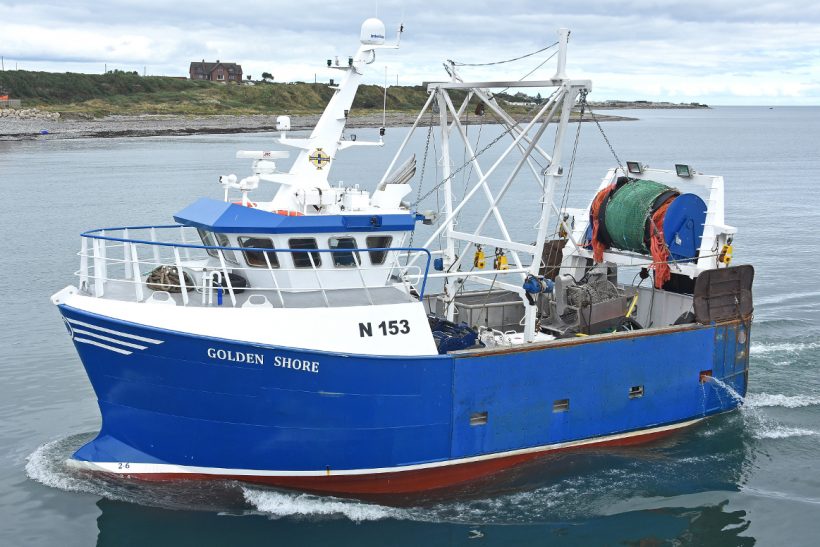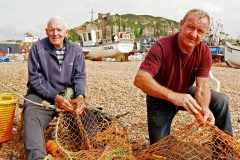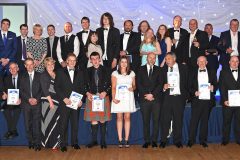Two months after Golden Shore N 153 was completed by Mooney Boats Ltd for G & H Chambers & Sons Ltd of Annalong, during which time the vessel has showcased her versatility by engaging in scallop dredging and queenie trawling, David Linkie caught up with her owners at Kilkeel to share their first impressions of the new build.
“Both in terms of fishing efficiency and seakeeping qualities, Golden Shore has returned a highly encouraging level of performance since being handed over to us (G & H Chambers & Sons) at Killybegs by Mooney Boats, and one that augers well for the future.
“While harder challenges undoubtedly lie ahead in the coming winter months, Golden Shore more than meets any expectations we might have had, and is well-suited to our long-term requirements. Full credit for this goes to designer Ian Paton, Lee Mooney and his team at Killybegs, and everyone else associated with the build and supply of machinery and equipment to Golden Shore.”
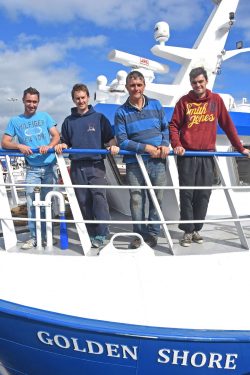
Paul Annett, Gareth, Geoffrey and Christopher Chambers are impressed with the level of performance Golden Shore returned in the first two months of fishing. (Crewman Gareth Graham was not available at the time this photograph was taken).
These were the initial thoughts of Geoffrey Chambers, who, together with his sons Christopher and Gareth Chambers, and crewmen Paul Annett and Gareth Graham, have now fished Golden Shore for eight weeks, during which time the 14.95m vessel has alternated between scallop dredging and queenie trawling.
This level of versatility, which in time will also include prawn trawling, highlights the well-established pattern of seasonal fisheries Golden Shore will engage in. These are expected to closely follow those that proved successful with the family’s previous boat, the Kilkeel-based, 17m wooden-hulled Lynn Marie N 264, and made the new build possible.
In addition to spanning two generations of a long-standing Annalong fishing family, Golden Shore is particularly significant in the fact that she is the first new, dedicated scallop vessel to be built for Co Down owners.
Golden Shore’s home port, Kilkeel, like the other two Co Down harbours of Ardglass and Portavogie to the north, have experienced severely challenging times since the introduction of the much-maligned cod recovery programme in the Irish Sea 14 years ago. Clearly, this had both an immediate and lingering negative impacts on the local fleet, as well as the equally important infrastructure ashore.
In recent years, a combination of sheer grit and determination displayed by a nucleus of forward-looking skippers, together with their representatives ashore and local processors, has led to the local fishing industry regaining some much needed momentum, which now needs to be carefully nurtured, as it is still very much a work in progress.
That brothers Christopher and Gareth Chambers, who alternate as skipper of Golden Shore when Geoffrey is ashore, are highly committed to the long-term future is extremely welcome news, which needs to be further encouraged with incentives, rather than obstacles, which has been the case for far too long.
Insured by Sunderland Marine, Golden Shore is initially expected to fish mainly in the Irish Sea, including the Manx grounds, which skipper Geoffrey Chambers has worked in line with the licensed seasonal king and queen scallop fisheries for many years now.
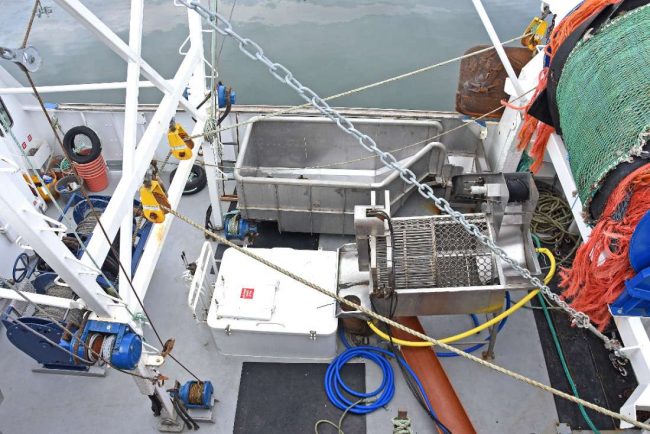
General view of the working deck.
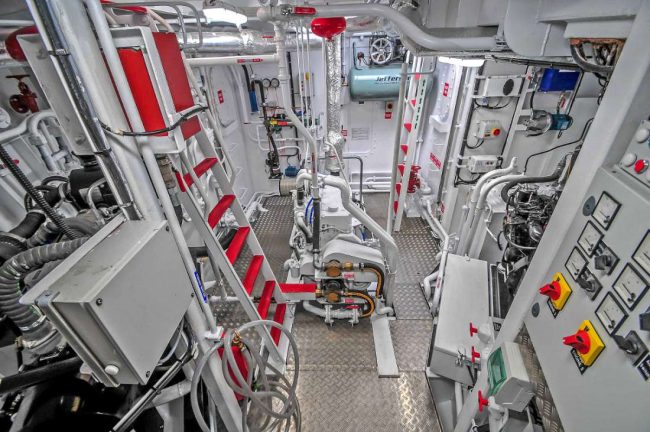
The spacious and well-arranged engineroom.
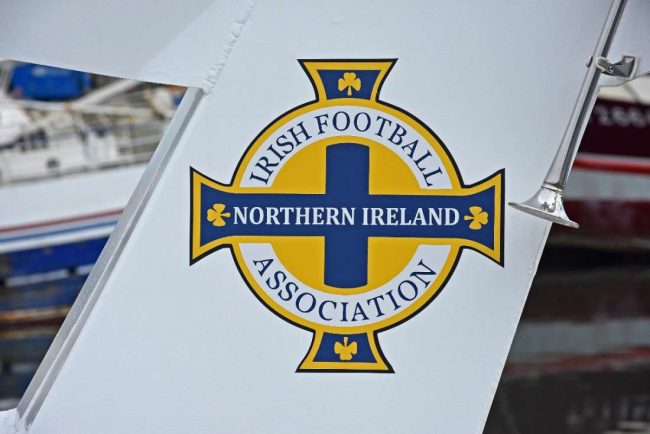
Always display your country’s colours with pride.
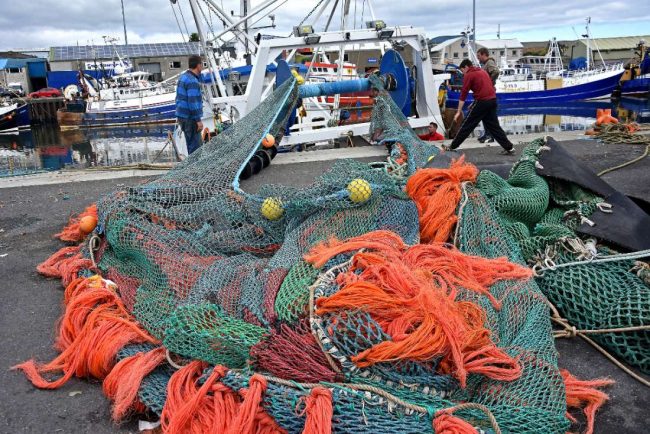
Taking Golden Shore’s 12-fathom queenie trawl onto the net drum in Kilkeel harbour.
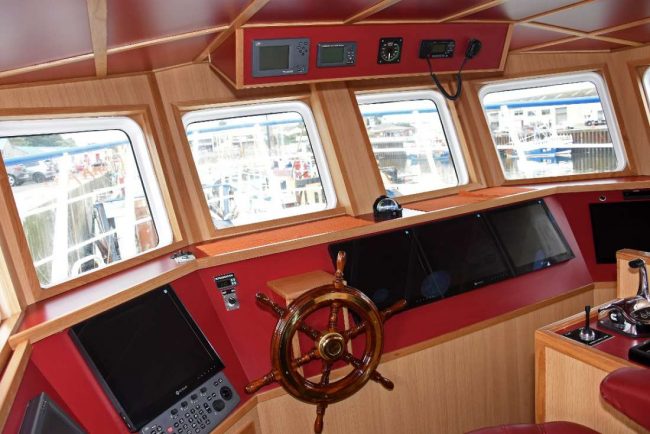
Wheelhouse interior.
When fishing around the Isle of Man, Golden Shore will usually land to Tim Croft and Billy Caley’s company, Island Shellfish Processing Ltd of Port St Mary. When fishing into Northern Ireland, Kilhorne Seafoods of Annalong will process queenies landed by Golden Shore, while scallops will go to Sea-Source in Kilkeel.
On taking the decision to investigate new build options, the owners subsequently contacted Naval Architect Ian Paton of SC McAlister & Co Ltd, and Mooney Boats, which at the time were fitting-out the 24m twin-rig prawn freezer trawler Patrick C DA 77 and preparing to start work on the 26.5m Audacious DA 14, again for Clogherhead owners.
Following further discussion with the designer, SC McAlister’s well-proven design of sub-15m hull was evolved in line with the owners’ requirements, which focused on fishing efficiency, safety and versatility.
The main dimensions of Golden Shore’s double chine steel hull are LOA 14.96m, registered length 14.15m, beam 6.05m, moulded depth 3.47m, draft 3.4m and gross tonnage 32t. When the hull design was completed, Mooney Boats started to cut the Lloyd’s Grade-A 8mm steel plate in-house, using their own CNC plasma profiling equipment.
A key feature of Golden Shore is the considerable amount of working space and good access available on the main deck. That this has been achieved while incorporating catch handling conveyers for use when dredging, as well as a dedicated queenie handling system and net drum, shows the extent to which the owners/designers/builders have used the room available to maximum effect.
Another significant characteristic of the working deck is the considerably higher than usual height of the straight gunwale rail. This is a result of the request for the catch conveyors to be positioned to avoid crewmen having to bend when picking scallops off the belt. This ergonomic criterium therefore effectively determined all the other vertical dimensions associated with the positioning of the catch conveyors.
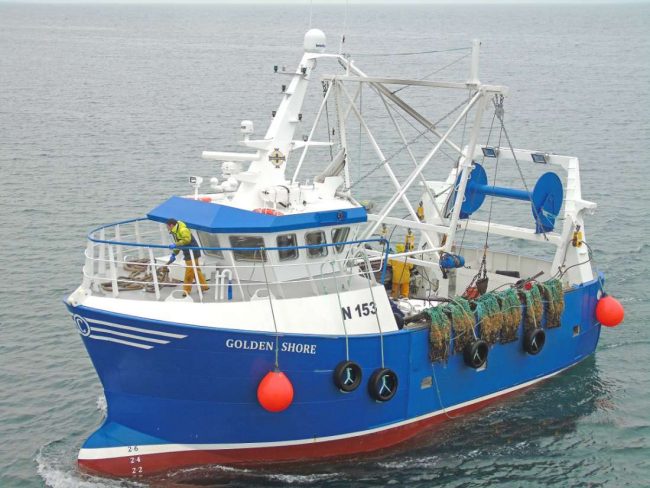
Golden Shore approaches Kilkeel for the first time after scalloping of the Co Antrim coast for the first month. (Photograph courtesy of Les Campbell).
Internal layout below deck from forward consists of forepeak, engineroom, fishroom, and steering gear compartment. A watertight door, situated forward of the starboard conveyor, gives access off the main deck into a crew changing area in the full-width steel deckhouse.
This area, which ensures that no protective deck clothing enters the vessel’s accommodation areas, leads inboard to the wheelhouse, galley/messdeck, shower/WC compartment, engineroom and cabin.
The mess table and seating is arranged forward towards the stem. The usual selection of electric cooking facilities, are positioned against the aft bulkhead.
A five-berth cabin is positioned along the portside of the deck casing at main deck level, accessed from the messdeck. Heating throughout the vessel, including the aft steering gear compartment, is 220V with thermostatic controls.
Golden Shore’s internal accommodation areas have been finished using solid oak and red laminate panel insets, to the high standards that Mooney Boats has quickly established as a trademark of its new builds.
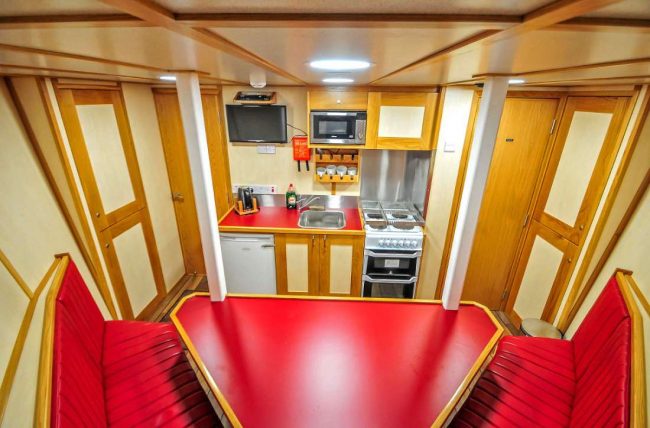
The well-equipped galley and messdeck is finished to a high standard.

Fishing activities are centred on a Rapp Marine 2-drum 15t trawl winch.
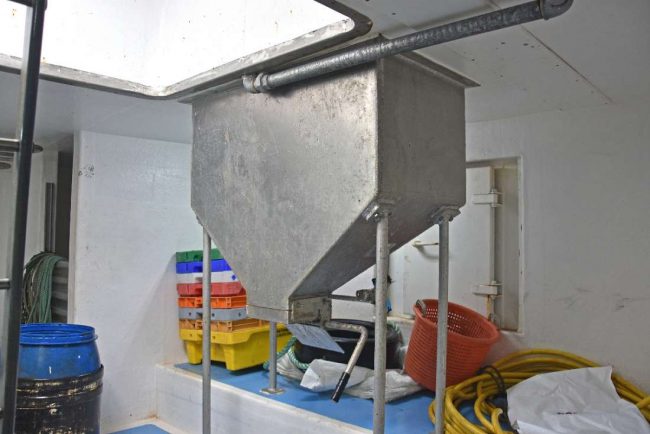
King and queen scallops are bagged from an aluminium reception hopper in the fishroom.
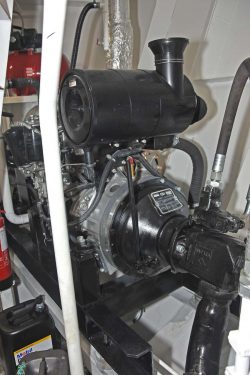
Two hydraulic pumps are driven by a Twin Disc clutch mounted on the aft end of the Mitsubishi 6D16 TE2 auxiliary engine, supplied by DR Diesel of Kilkeel.
Fishing activities on Golden Shore are centred on a 2-drum trawl winch manufactured by Rapp Marine UK Ltd. From the 15t winch, which can accommodate up to 310 fathoms of 22mm-diameter wire and is positioned centrally abaft the deck casing, the trawl warps are led upwards at 45° to hanging blocks mounted on the goalpost-style lifting gantry amidships, before leading aft clear of the working deck to a second set of Fleming Fairleads hanging blocks.
When scallop dredging, the hanging blocks are mounted towards the outer ends of the traditional towing arms, and on the outer face of the trawl gantry when Golden Shore is towing either a queenie net or a prawn trawl.
Of box section construction, the manually operated scallop arms are pivoted on the legs of the stern gantry above the main deck to give an almost horizontal position when towing the dredges. On changing over to queenie trawling, the spreaders are quickly released and lifted ashore to provide maximum space to work and securely store the trawl doors.
Two Pullmaster 5t topping Gilsons are mounted on the lifting gantry, at the base of which two 2t Gilsons are positioned to pull down the scallop dredges.
At the owners’ request, the tops of the gunwale rails where the dredges come in are capped with 6mm stainless steel plating in order to minimise abrasive wear and tear. Similarly, 25mm thick blue nylon sheeting, 7m long by 2m deep, is bolted to the outer hull sides with stainless steel bolts to give additional protection to Golden Shore where the scallop dredges come into contact with its port and starboard sides.
Golden Shore’s new rig of six-aside scallop dredges was manufactured by Kirkcudbright specialists Deeside Marine Ltd.
The scallop gear is towed by 100 fathoms of 20mm-diameter compact steel core wire supplied by Jim Hamilton of Kilkeel.
Michael Watt of Gamrie Bay Trawls supplied Golden Shore’s 12-fathom queenie net. Rigged on 12in discs, the queenie trawl is effectively towed directly from a set of 6ft 3in doors manufactured by Kilkeel Steel Products. 150 fathoms of 16mm-diameter wires, usually spooled on top of the heavier scallop dredge wire, are used for queenie trawling.
Arranging the accommodation cabin on the main deck created more space below it. This has been fully utilised by the designer and boatbuilder to create a spacious and extremely well laid out forward engineroom, in which all machinery is easily accessible for all levels of service in years to come. The main access down to the engine room is just off the main deck on the starboard side. Secondary access is from inside the accommodation space.
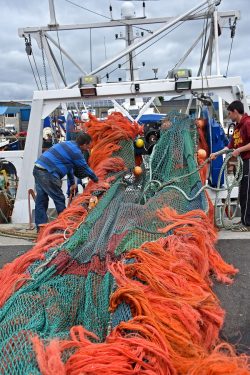
Pulling the well-protected 12-fathom queenie trawl, supplied by Gamrie Bay Trawls, onto the drum.
Golden Shore is powered by a Cummins QSM11 engine that develops 220kW @ 1800rpm and is coupled to a ZF W350 5.99:1 reduction gearbox to turn a 1600mm-diameter 4-bladed Teinbridge propeller in a matching fixed nozzle. This centreline combination returned a top speed of nine knots when Golden Shore ran engine trials of the coast of Co Donegal, since when the main engine has delivered a highly economical fuel consumption of around 30 litres per hour when running at 1500rpm and steaming at eight knots. This impressive level of fuel economy means that together with the two auxiliary engines, one of which runs continuously, Golden Shore uses no more fuel than her single-engined predecessor Lynn Marie.
Mooney Boats machined the 110mm stainless steel propeller shaft and stern tube in-house. The intermediate shaft is also stainless steel, and is joined to the tail shaft with a coupling which is accessed through a hatch in the fish room. A Cooper bearing is fitted just forward of the coupling to take up the weight and another at the engine room bulkhead to carry the weight of the shaft.
Two Jabsco 1½ inch 24-volt clutched fire and bilge pumps are driven off the front end of the main engine. Each pump has been piped so either one can be used for bilge suction or deck wash duties, or the two pumps can also be run simultaneously to get extra water flow when required.
The main auxiliary engine is a Mitsubishi 6D16-TE2 (106kW @1500rpm), supplied by DR Diesel of Kilkeel. This unit drives twin pumps for the vessel’s main hydraulic system through a Twin Disc clutch, mounted on the bellhousing, together with a 40kW generator at the front end.
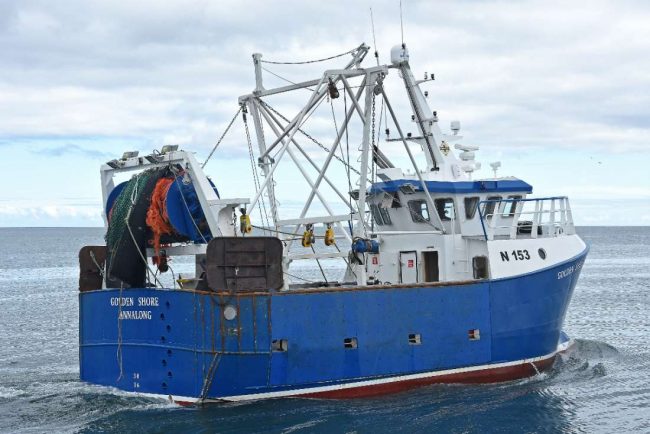
Starboard quarter view of Golden Shore.
A similarly-rated electrical generator is driven continually by a Mitsubishi SQ4 auxiliary, supplied by Ashvale Engineering, positioned on the port side of the engineroom. The main and two auxiliary engines are box cooled by Blockland coolers supplied by the yard.
Rapp Marine supplied Golden Shore’s hydraulic system, which was installed and piped by the boatyards before being commissioned by Rapp Marine, together with the deck machinery.
A hydraulic pump retrieve system is driven from a PTO on the gearbox. This pump is fitted with an air ram and electric solenoid, enabling the skipper to operate it from the wheelhouse. The retrieval pump is also used to drive either the twin catch conveyors when the crew are sorting the contents of the scallop dredges, or the queenie riddle, thereby eliminating the need to run the hydraulic engine after the gear has been shot back.
Twin deep wing tanks positioned against the engineroom aft bulkhead enable Golden Shore to carry up to 11,400 litres of fuel. A 3,700 litre capacity freshwater tank is located in the bulbous bow. All the wiring on Golden Shore was completed to an extremely high standard by Mooney Boats’ own electricians.
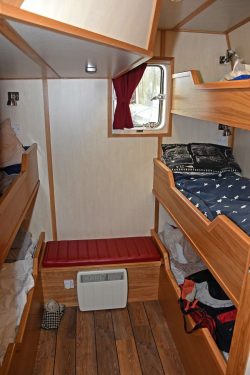
Five bunks are arranged in the accommodation cabin on the portside of the deck casing.
All external wiring is run on stainless steel cable trays and clipped neatly. The main distribution boards are fitted in the engine room port side, with subdistribution boards fitted in the wheelhouse.
The main electric system is a 3-phase/220-volt system which can be powered from either of the auxiliary engines. A 24-volt system is also fitted for emergency lighting and navigational equipment. LED lighting is used throughout to reduce energy consumption. Two banks of service and emergency batteries are fitted, backed up by a Victor Skyla-I 24/100 main and TG 24/50 backup chargers.
Wills Ridley steering gear is fitted.
On completion of all structural work on the vessel, Corrosive Solutions and Inspection Services Ltd (CSIS) painted the Golden Shore with a Jotun paint system supplied by the yard’s chandlery store.
Automated catch handling systems
Golden Shore is equipped with dedicated king scallops and queenie catch handling systems that are designed to deliver optimum levels of catch quality while also considerably reducing the crew’s workload.
When fishing king scallops, the contents of the dredges are released into stainless steel reception hoppers fitted along the port and starboard sides. On shooting back the gear, heavy-duty conveyor belts move the catch aft towards crewmen for selection. Filled baskets of scallops are then delivered via a chute down into a vertical storage aluminium hopper positioned towards the stern of the fishroom, from where they are later retrieved for bagging.
After the queenie trawl is hauled onto the elevated 10t net drum, fabricated by the yard with aluminium side flanges, the codend is lifted aboard using the starboard topping Gilson, before the contents are released into a large stainless steel hopper. This is located aft of the lifting gantry in place of the easily removable starboard scallop conveyor which can be quickly unbolted and lifted ashore.
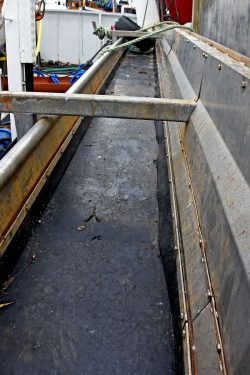
Looking aft along the portside scallop hopper and conveyor.
With a capacity for an estimated 50 bags, the after end of the queenie hopper is secured to the main deck via a pivoting mounting system. When the codend is released and taken aft again, the wire from the starboard topping Gilson is clipped on to the foreside of the hopper, enabling it to be gradually lifted up. This in turn allows the contents to flow aft onto an elevated hopper, which effectively picks them up from almost deck level, for delivery into a hydraulically-driven stainless steel queenie riddle located on the vessel’s centreline.
From the riddle, selected queenies are delivered to an aluminium storage hopper in the fishroom, while small queenies are returned to the seabed by a plastic chute leading across the deck towards the aft scupper on the portside.
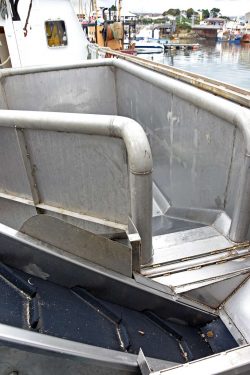
Queenies are delivered onto an elevated conveyor by gradually raising the fore end of the trawl reception hopper…
While in some ways this queenie catch handling system is similar to the one the owners used on their previous boat Lynn Marie, the one main difference is that queenies descend freely onto the conveyor, rather than being lifted out of the hopper by the conveyor. This change is expected to considerably extend the life of the rubber conveyor belts, by reducing the amount of weight and abrasion on them.
The stainless steel side conveyors and the queenie riddle system were custom-designed and manufactured by Joe Lynch of Greencastle, Co Donegal.
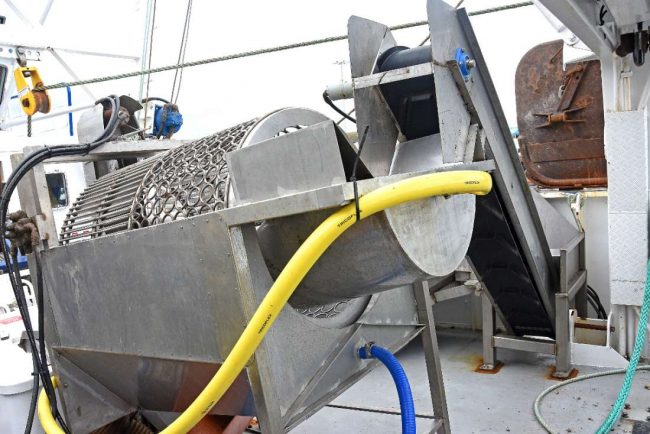
… before entering a hydraulically-driven stainless steel riddle…
Approximately 400 x 40kg bags of king/queen scallops can be arranged in Golden Shore’s large fishroom, which is 5.5m long and 2.5m high.
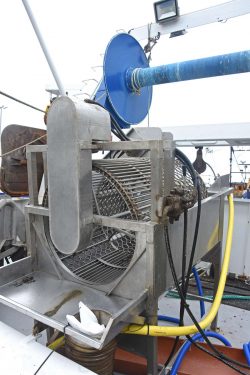
… from which selected shells descend via a chute to a hopper in the fishroom for bagging.
The fishroom sides and deck head were sprayed with insulation to a minimum thickness of 150mm and lined with ¾-inch marine plywood. On completion of this work, all exterior surfaces were fibre-glassed and gel coated. Two2t ice lockers are positioned aft on either side of the hatch leading to the steering gear compartment. Stainless steel refrigeration pipes are fitted to the underside of the deckhead. The fishroom refrigeration system is served by Blitzer compressor and a K073HB condenser units supplied by Cool Temp, which commissioned the system after it was installed by the yard.
Aluminium tread plate lift up panels arranged along the centreline give direct access to the shaft and bilge.
Kilkeel company supply wheelhouse electronics
Golden Shore’s electronic wheelhouse equipment was supplied, installed and commissioned by SIRM UK of Kilkeel (previously Selex ES). Centrally positioned on top of the steel deckhouse and whaleback, the aluminium wheelhouse provides a commanding all-round view.
Accessed from the starboard side, the customised interior features an extremely high quality of craftsmanship. The skipper’s NorSap 1500 seat is offset towards the portside, where it is flanked by wing and central consoles, ensuring that all controls for the electronic equipment are within easy reach.
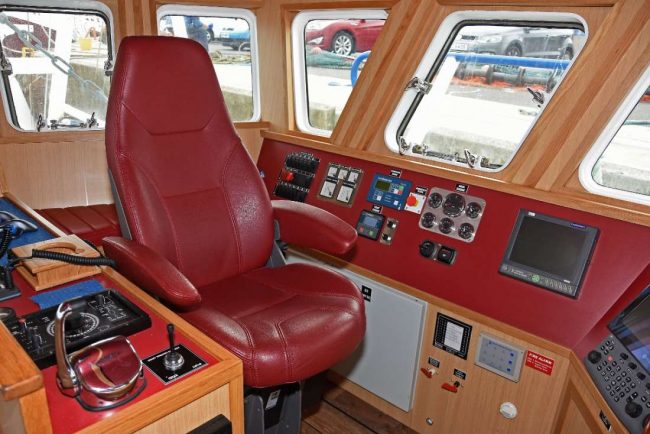
Golden Shore’s wheelhouse electronics equipment was supplied and installed by SIRM UK of Kilkeel.
Five 17in AG Neovo TFT screens are flush-mounted in the full-width forward console to provide skipper Chambers with a constant display of information on the seabed configuration relative to the scalloper’s location.
The importance of accurate vessel positioning relative to the selected, and usually small-scale, scallop grounds fished, is shown by the presence of an Olex 3D dual-screen seabed mapping and Trax Fishpro 6 plotting systems.
Details of the vessel’s location are processed by a Furuno GP32 GPS receiver and heading provided a JRC JLR-21 GPS compass. Bottom sounding is handled by a Hondex HE-7300 singlefrequency (50kHz) colour sounder.
The JRC JMA-5212 10kw radar is fitted with ARPA and AIS interfaces to provide tracking both through the radar display as well as the plotter. Steering and navigation is taken care of by a Navitron NT921 digital autopilot. A joystick control is positioned on the central island console, where the EC300 Power Commander electronic engine controls are also fitted.
Communications equipment installed on Golden Shore Icom IC-M323 DSC and Sailor 6210 VHFs, Sailor Fleet One sat-phone and Intellian I4P SAT TV.
Determination and experience overcome adversity
Golden Shore replaces the owners’ previous boat; the 17m wooden-hulled Lynn Marie N 264, which left Kilkeel last month for Peel after being bought by Billy Caley.
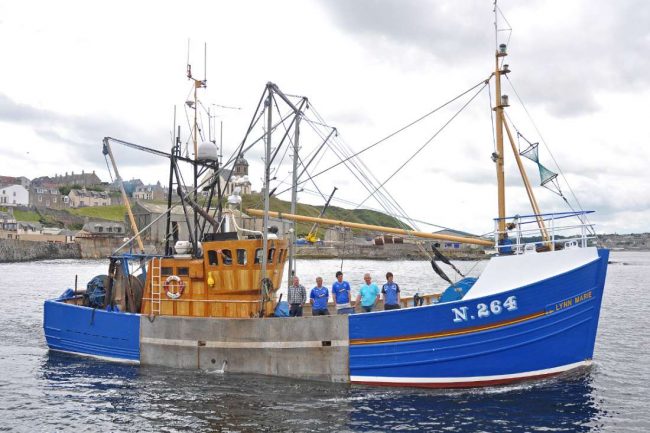
Recently sold to the Isle of Man, Lynn Marie…
Skipper Geoffrey Chambers bought Lynn Marie from Buckie in 2009, when the boat was rigged for scallop dredging in a large-scale conversion, to replace his previous command, the 17m Alexander Noble-built Prospector N 1 (ex BA 25, TT 24), which was sold to Jersey. Eighteen months later, Lynn Marie was badly damaged while on her way to scallop grounds south east of the Isle of Man when the scalloper was hit by the 155m container ship Philipp, which was on passage from Liverpool to Greenock in the Clyde and steaming at 16 knots. (Fishing News, 15 April 2011).
The severity of the impact resulted in the bow of Lynn Marie being knocked clean out by the weight and momentum of the 8971 GT container ship.
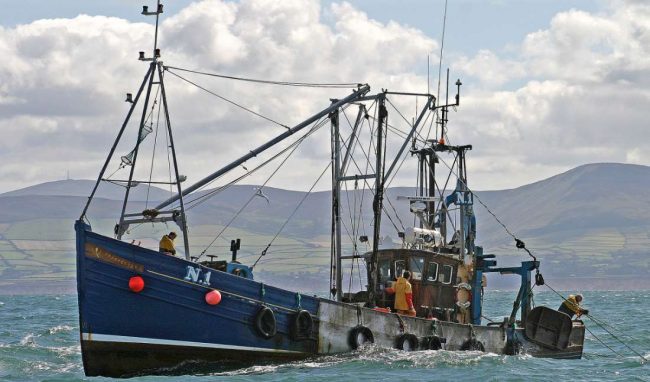
… replaced Geoffrey Chambers’ previous boat Prospector in 2009. (Photograph courtesy of Darren Purves).
After being safety escorted back to Port St Mary in a major rescue operation, Lynn Marie later berthed in Macduff harbour. On removal of all the damaged hull sections, a highly experienced team of four shipwrights from Macduff Shipyards fashioned and fitted a new oak apron, stem post, forward frame and 15 new hull planks, together with nine new deck stanchions, three steel deck beams, full forward decking, topside planking and gunwale rails in less than three months.
Lynn Marie BCK 86 was built by Herd & Mackenzie in 1973, for a local partnership headed by William Wilson, and fished from Buckie for 37 years while owned by the same family before being sold to Kilkeel.
Biblical connection to 153
Golden Shore’s PLN of N 153 was the number of Geoffrey Chamber’s great uncle’s first boat John Chambers N 153, which he was pleased to be allocated when he applied for it for the new family boat.
The significance of the number 153 centres around the New Testament reference to the miraculous draught or catch of fishes (John 21:1 – 11), when Peter, together with some other disciples, had fished all night for nothing in the Sea of Galilee.
In the morning, a man on the shore (they did not know it was Jesus) shouted to them to cast their net to starboard, as a result of which 153 great fish were dragged to the shore.
Golden Shore N 153
DETAILS
Owners: G & H Chambers and Sons Ltd, Annalong, Co Down
Designer: S C McAllister & Co Ltd
Boatyard: Mooney Boats Ltd, Killybegs, Co Donegal
DIMENSIONS and CAPACITIES
Length overall: 14.96m; Length reg: 14.15m; Beam: 6.05m; Depth moulded: 3.47 m; Draft: 3.4m; Tonnage: 32 tonnes gross; Fuel: 11,400 litres; Fresh water: 3,700 litres; Lube oil: 100 litres; Hydraulic oil: 750 litres; Fishroom: 400 x 40kg scallop bags
ENGINEROOM
Main engine: Cummins QSM11 of 220 kW @ 1800rpm driving through a ZF W350 5.99:1 reduction gearbox to a 1600mmdiameter four-bladed Teinbridge propeller. Speed: 9 knots Auxiliary engines: Mitsubishi 6D16 TE2 of 106Kw @ 1500 rpm driving main hydraulics through a Twin Disc N BDP 290/150 SAE 3 clutch and a 40kW generator; Mitsubishi SQ4 24kW @ 1800rpm driving 40kW generator
DECK MACHINERY
Supplier: Rapp Marine Ltd Peterhead
2 drum trawl winch 15t; 2 x Pullmaster topping winches 5t; 2 x Pullmaster pulling down winches; single net drum 10t Mooney Boats
FISH HANDLING/FISHROOM
King/Queen scallop handling systems: Joe Lynch, Greencastle; Fishroom chilling: Cool Temp Refrigeration
ELECTRONICS
Supplier: Selex Communications, Kilkeel
Fish detection
Hondex HE-7300 single frequency 50kHZ colour sounder echosounder
Navigation
JRC JMA-5212 10kW radar; 2 x Furuno GP-32 GPS navigators; Olex 3D and Trax Fishpro 6 plotting systems c/w with AIS, Arpa and tide modules; Navitron NT921 MK2 autopilot c/w Navitron rudder angle indicator and watch alarm; JRC JLR-21 GPS compass; Digital Yacht AIT2000 AIS Class B transceiver
Communications
Icom IC-M323 DSC VHF; Sailor 6210 VHF; Standard Horizon VLH3000 Intercom system; Sailor Fleet One maritime broadband system; Intellian I4P SAT TV
FISHING GEAR
Warp supplier: Jim Hamilton, Kilkeel 2 x 150 fathoms of 16mm-diameter trawl wire and 2 x 100 fathoms of 20mm scallop dredging wire; King scallop dredges: Deeside Marine Ltd. Kircudbright; Queenie trawl: Gamrie Bay Trawls, Gardenstown; Trawl doors: Kilkeel Steel Products 6ft 3in
ACCOMMODATION
1 x 5 berth cabin
GENERAL
Engine controls: Twin Disc EC300 Power Commander; Insurance: Sunderland Marine; Lifesaving appliances: Mooney Boats Ltd; Paint: Jotun; Steering: Wills Ridley; Wheelhouse seat: NorSap 1500

Read more from Fishing News here or for more commercial fishing boats, old and new, head to our Boat of the Week section.


Two months after Golden Shore N 153 was completed by Mooney Boats Ltd for G & H Chambers & Sons Ltd of Annalong, during which time the vessel has showcased her versatility by engaging in scallop dredging and queenie trawling, David Linkie caught up with her owners at Kilkeel to share their first impressions of the new build. “Both in terms of fishing efficiency and seakeeping qualities, Golden Shore has returned a highly encouraging level of performance since being handed over to us (G & H Chambers & Sons) at Killybegs by Mooney Boats, and one that augers well for the future. “While harder challenges undoubtedly lie ahead in the coming winter months, Golden Shore more than meets any expectations we might have had, and is well-suited to our long-term requirements. Full credit for this goes to designer Ian Paton, Lee Mooney and his team at Killybegs, and everyone else associated with the build and supply of machinery and equipment to Golden Shore.”

Paul Annett, Gareth, Geoffrey and Christopher Chambers are impressed with the level of performance Golden Shore returned in the first two months of fishing. (Crewman Gareth Graham was not available at the time this photograph was taken).
These were the initial thoughts of Geoffrey Chambers, who, together with his sons Christopher and Gareth Chambers, and crewmen Paul Annett and Gareth Graham, have now fished Golden Shore for eight weeks, during which time the 14.95m vessel has alternated between scallop dredging and queenie trawling. This level of versatility, which in time will also include prawn trawling, highlights the well-established pattern of seasonal fisheries Golden Shore will engage in. These are expected to closely follow those that proved successful with the family’s previous boat, the Kilkeel-based, 17m wooden-hulled Lynn Marie N 264, and made the new build possible. In addition to spanning two generations of a long-standing Annalong fishing family, Golden Shore is particularly significant in the fact that she is the first new, dedicated scallop vessel to be built for Co Down owners. Golden Shore’s home port, Kilkeel, like the other two Co Down harbours of Ardglass and Portavogie to the north, have experienced severely challenging times since the introduction of the much-maligned cod recovery programme in the Irish Sea 14 years ago. Clearly, this had both an immediate and lingering negative impacts on the local fleet, as well as the equally important infrastructure ashore. In recent years, a combination of sheer grit and determination displayed by a nucleus of forward-looking skippers, together with their representatives ashore and local processors, has led to the local fishing industry regaining some much needed momentum, which now needs to be carefully nurtured, as it is still very much a work in progress. That brothers Christopher and Gareth Chambers, who alternate as skipper of Golden Shore when Geoffrey is ashore, are highly committed to the long-term future is extremely welcome news, which needs to be further encouraged with incentives, rather than obstacles, which has been the case for far too long. Insured by Sunderland Marine, Golden Shore is initially expected to fish mainly in the Irish Sea, including the Manx grounds, which skipper Geoffrey Chambers has worked in line with the licensed seasonal king and queen scallop fisheries for many years now.

General view of the working deck.

The spacious and well-arranged engineroom.

Always display your country’s colours with pride.

Taking Golden Shore’s 12-fathom queenie trawl onto the net drum in Kilkeel harbour.

Wheelhouse interior.
When fishing around the Isle of Man, Golden Shore will usually land to Tim Croft and Billy Caley’s company, Island Shellfish Processing Ltd of Port St Mary. When fishing into Northern Ireland, Kilhorne Seafoods of Annalong will process queenies landed by Golden Shore, while scallops will go to Sea-Source in Kilkeel. On taking the decision to investigate new build options, the owners subsequently contacted Naval Architect Ian Paton of SC McAlister & Co Ltd, and Mooney Boats, which at the time were fitting-out the 24m twin-rig prawn freezer trawler Patrick C DA 77 and preparing to start work on the 26.5m Audacious DA 14, again for Clogherhead owners. Following further discussion with the designer, SC McAlister’s well-proven design of sub-15m hull was evolved in line with the owners’ requirements, which focused on fishing efficiency, safety and versatility.

